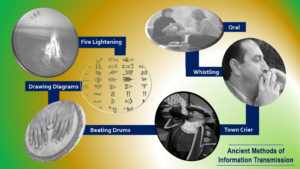Back to: Computer Studies JSS1
Welcome to class!
In today’s class, we shall be talking about ancient and oral method of transmitting information. Please enjoy the class!
Ancient Methods of Transmitting Information – Oral method

For millennia, before the rise of written words and modern communication technologies, information flowed through the human voice. The oral method of transmitting information, although seemingly primitive, served as a powerful and dynamic tool for sharing knowledge, history, and culture across generations.
Origins and Significance:

Cradle of Communication: The oral method predates recorded history, emerging alongside the evolution of human language itself. It served as the primary means of communication for early civilizations, fostering social cohesion, sharing survival skills, and transmitting cultural values.
Memory and Performance: Information was encoded in stories, songs, poems, and chants, relying heavily on memory and performance. Skilled storytellers, bards, and elders played crucial roles in preserving and disseminating knowledge across generations.
Cultural Expression: The oral method was deeply intertwined with cultural practices. Myths, legends, and folktales not only entertained but also embedded moral values, social norms, and historical narratives within communities.
Advantages and Limitations:
Accessibility and Flexibility: The oral method required no specialized tools or literacy, making information readily accessible to all within a community. Stories could be adapted and embellished, allowing for flexibility and cultural evolution.
Promotes Social Interaction: Oral communication necessitates face-to-face interaction, fostering social bonds and building strong communities. The shared experience of storytelling strengthened social memory and collective identity.
Limitations of Oral Method of Communication
Loss and Distortion: Information transmitted orally is susceptible to distortion and loss over time. Details could be forgotten, embellished, or altered with each retelling, potentially impacting the accuracy and integrity of the information.
Limited Range: The oral method was restricted by physical distance and the limitations of human travel. Information could only travel as far as the speaker’s voice could reach, hindering communication over vast distances.
Legacy and Influence:
Foundation of Storytelling: The oral tradition laid the foundation for modern storytelling techniques, influencing literature, theater, and film. The use of narratives to engage and inform audiences continues to be a powerful tool in communication today.
Impact on Language: The oral method shaped the development of languages, influencing vocabulary, grammar, and pronunciation. Dialects and regional variations emerged due to localized transmission and cultural influences.
Preserving Cultural Heritage: Oral traditions are considered valuable repositories of cultural heritage, offering insights into past societies, beliefs, and values. Modern efforts focus on documenting and preserving these traditions through audio recordings and written transcriptions.
The oral method of transmitting information, despite its limitations, stands as a testament to human ingenuity and adaptability. It highlights the power of language, storytelling, and shared experience in shaping societies and preserving cultural heritage. While modern communication technologies have surpassed the reach and accuracy of the oral method, its legacy continues to inspire and inform our understanding of communication and the human experience.
We have come to the end of today’s class. I hope you enjoyed the class!
In the next class, we shall be discussing Ancient Methods of Transmitting Information – drum beating.
In case you require further assistance or have any questions, feel free to ask in the comment section below, and trust us to respond as soon as possible. Cheers!
Question Time:
- Briefly explain the origin and significance of the oral method of information transmission.
- Describe the advantages and limitations of the oral method compared to modern communication technologies.
- How did the oral tradition impact the development of language and storytelling techniques?
- Discuss the importance of oral traditions in preserving cultural heritage.
